
Videos
Regulating Social Media: America’s Global Communications Dilemma
Reports & Papers
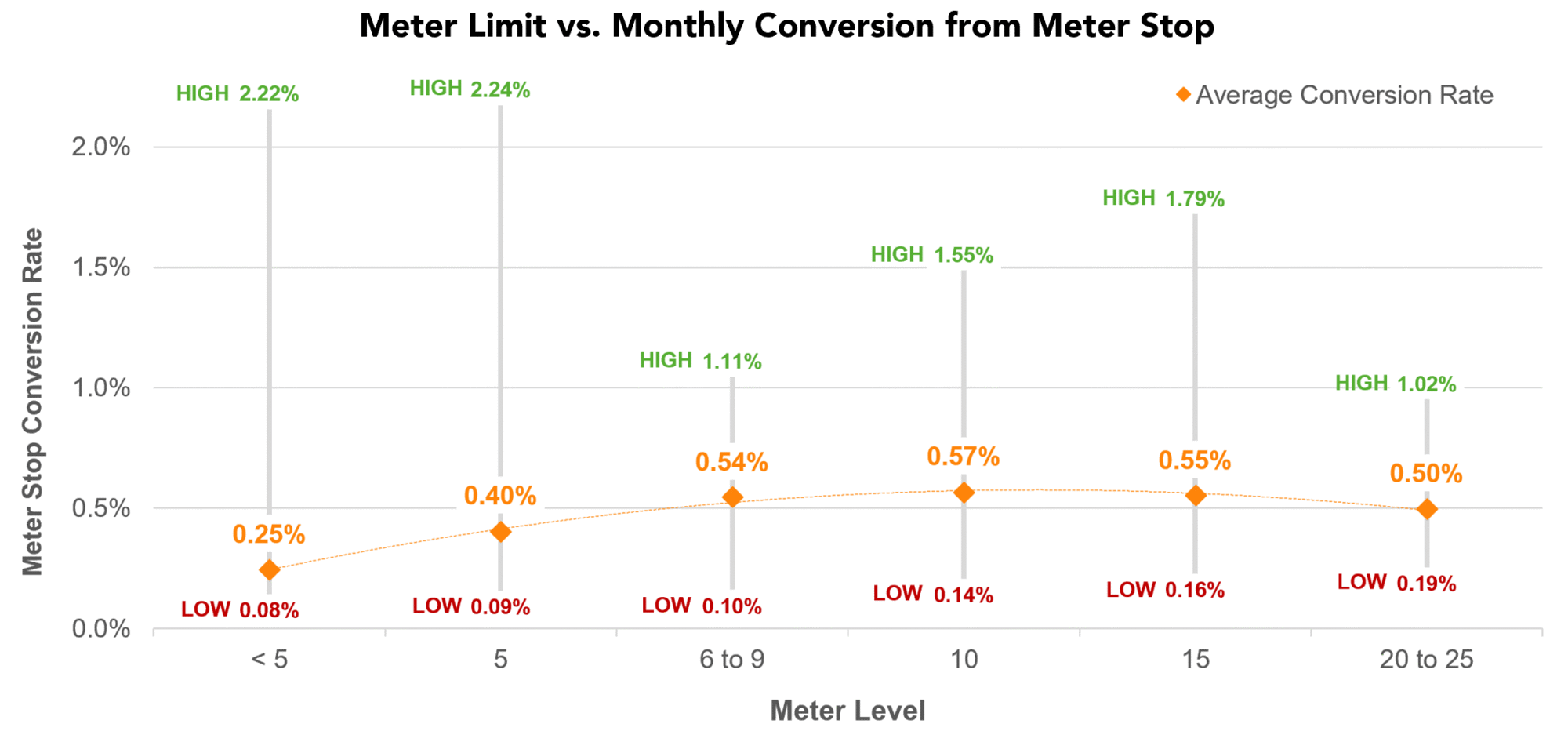
A Shorenstein Center and Lenfest Institute White Paper
Read and download the PDF version of this paper here.
The views expressed in Shorenstein Center Discussion Papers are those of the author(s) and do not necessarily reflect those of Harvard Kennedy School or of Harvard University.
Discussion Papers have not undergone formal review and approval. Such papers are included in this series to elicit feedback and to encourage debate on important issues and challenges in media, politics and public policy. Copyright belongs to the author(s). Papers may be downloaded for personal use only.
The past half-decade has seen a digital subscription renaissance in the news publishing industry. Publishers are increasingly recognizing a market demand for high-quality, meaningful, trustworthy content, and in turn seek to cultivate premium, high-value brands that engage readers.
Our research suggests publishers should invest in capabilities to engage in constant testing and experimentation in digital — to build engagement among digital audiences and ultimately convert engaged readers into paying subscribers. For commercial and for-profit models in particular, publishers should become smart across a range of new strategies, including how to configure meters and rules to calibrate a mix of free and paid access. The trends we have observed across the publishers studied suggest pricing models, marketing tactics, and new approaches to audience engagement can help publishers succeed in a news environment increasingly friendly to robust digital programs.
Produced through surveys of more than 500 for-profit newsrooms, this research suggests new best practices to aid publishers in increasing and sustaining digital subscriptions. This initiative complements existing research at the Shorenstein Center on Media, Politics and Public policy uncovering sustainable business models for local news and nonprofit publishers.
This paper begins with recommendations for publishers to propel shifts to subscriber-focused models, how to define their news organization’s market, and how to measure engagement within that market. They are followed by a set of suggested strategies to drive a reader’s intent to subscribe, and to maintain that digital subscribership once that reader has entered a publisher’s ecosystem.
Our research suggests a shift from advertising-based models to digital subscriptions enables news organizations to deliver more reader-relevant content, validate operational models that offer more stable business performance, and free up resources to plan for longer-term investments in content and news quality.
What you need to know from the report:
The benchmarks and recommendations in this document are based on data from more than 500 news organizations with digital subscription or membership models between 2011 and 2018. As a survey of a range of large and small news organizations, the recommendations use aggregated data to suggest where publishers perform across their digital subscription businesses. These benchmarks are meant as broad recommendations for publishers to contextualize and estimate performance and subscriber growth associated with a particular strategy or set of related tactics, relative to their peers.
A substantial portion of the data was collected directly from the Press+ digital subscription system, a technology platform used by several hundred news organizations between 2011 and 2016 before the company merged with Piano Media. Publishers using Press+ opted into sharing data about their digital subscription performance on the condition that be shared only in an aggregated, anonymized format. This data was extracted directly from the back-end subscription system, rather than via publisher surveys, and only covers the time period up to 2015.
Data added to the data set since that time has been collected using publisher surveys in a number of contexts, such as individual consulting engagements, industry collaborations such as the Facebook Local News Subscription Accelerator, and the Knight-Lenfest Table Stakes program. In all cases, data was provided on the condition that it be shared only in an anonymized and aggregated manner. The surveys captured simpler, base metrics such as total subscribers or total unique visitors to remain consistent with the style of data extracted from the back-end subscription system. The authors then applied those raw data to formulas to generate more advanced metrics, such as conversion rates or retention rates, where possible. An example of that extraction matrix is available here.
This benchmark data was derived from a variety of organizations, including national and leading metro publications, local publications, and digital-only brands. The vast majority of data – more than two thirds of publishers in the data set – comes from local, regional and metro-area newspapers in the United States. Some metrics, such as market penetration rate, were compiled from publicly-available data. Certain private data were provided on the condition that metrics and benchmarks are anonymized. Not every publication that provided data did so for every KPI or benchmark.
Communities – and the news publishers that serve them – increasingly need for new business models that can sustainably support the production of quality journalism. The University of North Carolina’s School of Media and Journalism reports that more than 1,300 communities in the United States have lost local news coverage entirely since 2004.1
As traditional news outlets continue to reduce staff and streamline operations, that figure may increase as both for-profit and nonprofit newsrooms face pressure from readers, investors, and stakeholders to stabilize, grow, and, ideally, innovate new ways of bringing news to the communities that need them.
Across our research, many for-profit news organizations faced the challenge we call the revenue trap of the digital advertising business model. Digital advertising models require large volumes of pageviews, which can incentivize sensationalism, virality, or “copycat” editorial efforts rather than encourage quality, independent journalism. Across the publishers analyzed, we found volume-driven digital advertising engenders a race-to-the-bottom to produce the lowest-cost, highest-volume content.2 3 4 Publishers reliant on digital advertising generally see business goals as increasingly distant from editorial priorities.
Conversely, digital subscriptions require growing the number of users who are highly engaged in a publisher’s content. Across the news organizations surveyed, when users pay for access to news content, the business goals of a news organization more closely meet editorial goals. This shift in the key underlying unit of growth – from page views to engaged readership – incentivizes publishers to invest in content that is valuable to readers. We found this holds at for-profit news organizations, where reader revenue models align business goals with editorial goals, as well as nonprofit newsrooms, where membership models ask readers to support journalism they find most valuable.
Our findings suggest digital news consumers will indeed pay for access to high-quality content, particularly when they are presented with compelling, relevant information and marketing messages that inspire deep and ongoing engagement. Publishers succeeding in growing digital subscriptions are outperforming the median by a factor of 10.5
The alignment of editorial intent and business performance comes with a better understanding of growing and sustaining engaged subscribership. Comparing performance across markets and operations to distill key insights, the compiled benchmarks offer suggestions for publishers to understand where they fall relative to a cross-section of news organizations. The 99th percentile among publishers in the datasets studied suggests most effective strategies – and are supported by recommendations for how they might deploy these strategies in their organizations.
Under digital subscription model, a news organization’s audience can be understood through the publisher’s funnel – with the broader addressable market represented atop the funnel; engaged users represented as the funnel narrows; and paying, loyal subscribers at the narrow bottom.
The publishers studied had largely coalesced around this model, moving readers from discovery and engagement, to subscribing and sustaining subscribership – while ultimately aiming to broaden the funnel to increase their share of engaged subscribers. The below benchmarks correspond to these stages of the audience funnel.

Key Finding: A well-defined market target leads to larger and more engaged digital audiences, among the publishers studied.
Publishers that performed above their peers across the news organizations and market dynamics studied tended to base their digital strategies on a well-defined market, and scoped their editorial objectives to best serve that market. Anecdotally, some publishers studied that have successfully deployed digital subscription strategies have derived a clear market definitions from their legacy print audiences.
In digital subscriptions, the publishers studied measured their market by the digital audiences within that geography and region, and unique visitors relative to that – the market penetration. While a news organization’s overall market penetration is not the most reliable indicator of a publisher’s success, it provides a useful signal of a publisher’s strength in its geography.
The publishers studied on this metric that demonstrated the greatest market penetration – Minneapolis Star Tribune Network and Boston Globe Media sites – perform more effectively relative to their peers.
A review of market penetration that examined various news organizations’ unique visitors as a percentage of total digital desktop audience in their market showed the Star-Tribune with a market penetration rate of 31%, nearly double the median. The Boston Globe performed second-best of the organizations studied, with a 23% market penetration rate. According to figures from Pew Research Center, publishers should seek to match or approach the 18-21% year-over-year increase in unique visitors industry-wide.Barthel, Michael “Newspaper Fact Sheet.” Pew State of the News Media. 6
These high performers suggest that if a publisher establishes itself as a unique and essential source of news in its market, beyond what might be a legacy print presence, it can likely generate significant digital demand. Both of these organizations were early adopters of paywalls and meters – these tests meant the publishers could begin to prioritize reader and subscriber engagement over advertising revenue, leading to more reader-focused editorial strategies.78 9 This approach begat a virtuous cycle of quality coverage within their respective markets that generates further subscriptions and continued engagement among existing subscribers.
Key Finding: Growing digital audiences into “regular readers” requires a defined audience engagement strategy.
The publishers studied generally shared definitions for their digital audiences – and the most effective strategies to reach and engage them. Across data provided by 15 metro area publishers, we saw the following proportions of digital audiences10
Publishers with high engagement see a higher volume of these regular readers. News organizations with larger-than-average “regular readership” – engaging that critical nine percent of audiences – tended to prioritize audience engagement efforts, including social media content promotion, in-situ recommendation engines, dedicated newsletters, and dedicated audience development teams. Our research found the most successful publishers test and deepen one or two of these audience engagement verticals to test which strategies most effectively drive one-time and occasional readers to increase their readership.
Key finding: Most publishers are too generous and need to stop more readers to force conversion.
Across publishers studied who had metered or “freemium” subscription models, their operations focused on building a critical metric: the stop rate, the percentage of all digital users who are “stopped” by a subscription prompt, a paywall, or a meter limit. The stop rate is calculated by the number of users stopped by a meter or paywall in a given month over the number unique visitors during that period.
A majority of the publishers studied across this metric are stopping a limited proportion of readers relative to their overall audiences. Among the more than 500 news organizations analyzed, the fiftieth percentile of publishers stops only 1.8 percent of their readership with a paywall or meter. Publishers with “sustainable” digital businesses report stop rates between the 80th and 90th percentiles of all publishers studied (at or above 4.2% of all readers). The publishers that reported more than 6% of unique visitors reaching their stop threshold had “thriving” digital subscription businesses – robust teams, and well-developed audience engagement strategies.

Among our most significant findings is that a majority of the publishers studied lagged behind thriving news organizations in their stop rate. Definitionally, a publisher with a low stop rate is only asking a small and likely insufficient percentage of their readership to subscribe. Even if the news organization is successful in converting their addressable audiences and unique visitors, publishers that are underperforming likely have limited opportunity to grow subscribers if they are failing to stop a significant enough portion of their overall readership.
A news organization’s stop rate often distinguishes high-performing publishers. The large metropolitan daily newspapers studied report stop rates approximately double the industry as a whole, with a median stop rate of 3.64 percent. These publishers often invest heavily in audience development, effective newsletters and social media marketing to circulate their content to build engagement. Publishers like the youth-focused Mic report a high return on investment around the developing customized and niche strategies by channel within their engagement activities unit. News organizations with smaller engagement teams might first focus on one key channel – newsletters – and optimize through testing multiple approaches to messaging.11
Publishers can understand why their stop rate is high or low by isolating stop rates by platform and channel; testing meter rules including the duration and number of pieces of content included in the meter; and benchmarking their audience engagement within their market, or against other similar publishers in other geographies or with similar-sized digital audiences or sophistication. Technical challenges can also be a source of challenge: the majority of meter stops are driven by desktop. Mobile stop rates lag those of desktop due in part to the technical challenges of implementing mobile metered paywalls; news organizations that have not optimized these channels might be missing opportunities to bolster their stop rate.
Key finding: There are two primary ways for publishers to increase their stop rate: (1) increase engagement or (2) tighten access rules.12
In assessing access rules, publishers can test various metering rules or the duration of their meter (e.g. expanding a user’s meter refresh window from 30 days to 45) to identify the levers to improve their stop rate to match those of the highest-performing publications identified above.
Based on work with publishing groups representing more than 500 publications with digital subscription models, the following recommendations can help guide efforts to improve a news organization’s stop rate:

A majority of publishers with metered models set their meter limits at 5 articles per month or lower. The graphic below represents this distribution, and the general shift in the data from January 2012 to present.
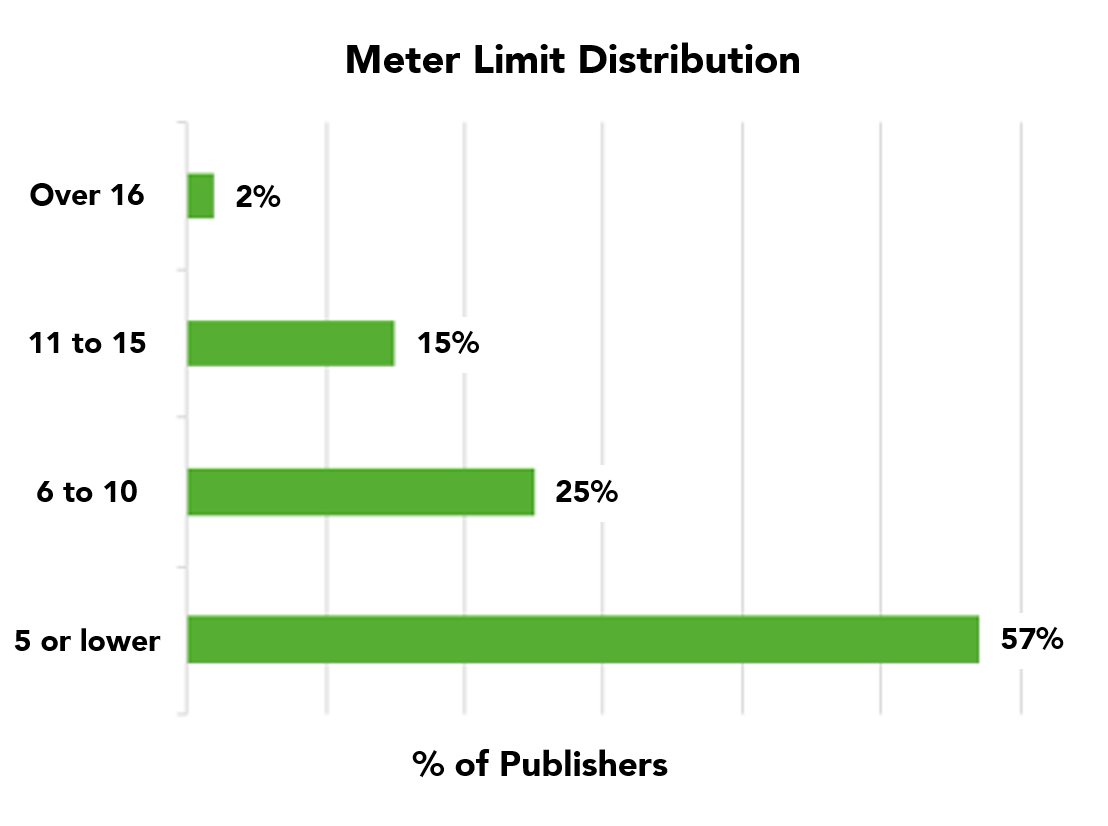
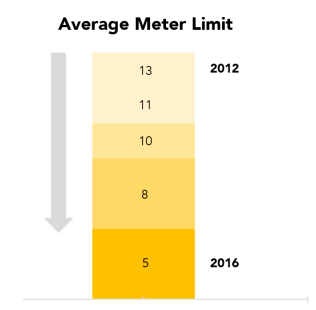
As meters were first introduced, several publishers studied were concerned meter limits might fail to attract subscribers or would constrain advertising revenue; many of these publishers set high meter limits or allowed users to circumvent the paywall. For example, when McClatchy began implementing metered models, it set its meter limits at 25 articles per month and excluded clicks from social media and email newsletters. After seeing a dip in successful conversions, McClatchy increased the types of clicks that counted toward a user’s limit.13 As publishers have experimented, and readers have become accustomed to digital subscription, meter limits have tended to decline among the publishers studied and within the industry at large.14
Clearly Defining What Counts within a Meter – Access rules play an important role in improving publishers’ stop rates. These rules include what content is included in a news organization’s meter, and what referrals or referral sources count toward the meter rate. According to publisher interviews, our research found best practice for access rules overall – regardless of the strategies used – is to clarify these rules in a manner your audience engagement team and the average reader can understand.
Excluding Content from a Meter – Successful publishers studied had clear rules for what content was excluded and why; clearer guidelines allowed for more tests of meter strategies and approaches. Higher-performing publishers studied tended to include nearly all article or content elements within their meter, offering limited exception. Instead of constraining meter rules to attract a particular audience, including more content types within a meter generally increased the likelihood that a variety of readers and digital users would ultimately reach a meter limit and encounter a subscription message.
Common Exceptions to a Meter – Meter exceptions still can prove important for revenue-related aspects of a publisher’s business. Our cross-analysis of publisher meters found that common exceptions to a meter included paid content such as obituaries, automobile sales, classifieds, and sponsored content as well as sections of content around which the publisher has seen extremely high return on investment on advertising. Typically, if a content element is solely used for advertising or branded content purposes, it will be excluded from the meter. Developing a meter exception strategy means understanding the advertising and subscription value derived from all content types; typically, publishers can weigh advertising yield against their average revenue per subscriber to evaluate whether to exclude a particular section from a meter.
Content-Specific Metering – In customizing meter rules to reach particular audiences, publishers studied frequently target messaging or refine metering experiences based on category of content – e.g. when reaching their meter limit, a sports reader stopped on local sports coverage might be served a customized message tailored to that team’s coverage. Generally, our surveys found driving toward a particular reader’s interests within a certain category of content allowed publishers to more efficiently drive toward the subscription action.
Increasing Opportunities To Encounter The Meter– In addition to the inclusion or exclusion of particular content from their meter rate, publications studied leveraged geographic targeting, content targeting (lowering the meter rate for more editorially-intensive content), or behavioral targeting (incorporating factors about a user, including newsletter subscription, to increase their meter limit). Others might use propensity targeting (leveraging a propensity to subscribe score, a strategy observed in more sophisticated news organizations including the Wall Street Journal), or an ad block intercept (including a subscription message customized to invite the reader to the subscribe or turn your ad blocker off to continue to read content before the average meter stop).
Key finding: Friction in the purchase experience (delays in page load times, unclear instructions, extra data fields, or confusing presentations of an offer) have a dramatic effect on conversion.
Following the meter stop, the highest-performing publishers studied tended to focus their strategies around their paid stop conversion rate (PSCR), or total users who subscribe in a given month over total users stopped by a meter, wall, or gateway. Across the news organizations in our survey, stop limits and conversion rates tended to be strong predictors of subscription growth. The stop rate multiplied by the PSCR and by the publisher’s unique visitors generates the number of new subscriptions sold in any given month. Conversion emerged as a critical differentiator for sustainable publisher businesses; while the top decile of publishers studied generally converted an average of 1.3 percent of stopped unique visitors per month, the median 50 percent of publishers only converted 0.5 percent of unique visitors.15
Meters and conversion rates tended to provide learning opportunities for publishers across the news organizations surveyed. A publication’s conversion rate is generally a function of three top-level factors:
While each publisher’s audience differs, profiling likely subscribers appeared to help publishers hone and test strategies unique to their markets. Publishers that tested various propensity models reported that factors such as reading content in multiple section categories, following a brand on social media, or subscribing to a publication’s newsletter were common factors and determinants of a particular reader’s propensity to subscribe. One publisher who had engaged in extensive propensity modeling, for example, reported that newsletter subscribers or those who have provided emails were 5-10 times more likely to subscribe.16
Don’t skimp on smart marketing: Publishers with high conversion rates engage in sustained, proactive marketing efforts targeting their most engaged users with discounts, offers, and clear explanations of the benefits of subscription. (Best practices for doing so are discussed in a later section.)
Frictionless purchase: The lower-performing publishers studied often paid little attention to the last step in converting a subscriber: the act of registering for an account and making a purchase. Small changes in the purchase experience for a user – such as slight delays in page load times, unclear instructions, extra data fields, or confusing presentations of an offer – can lead a user to abandon their purchase.
Data from 10 major metropolitan newspapers showed that, on average, publishers saw an average 90 percent drop-off of users once they enter the subscription process along the purchase and conversion funnel.17 On average, only 29 percent of desktop users who saw the first step of the purchase funnel (presentation of offers and pricing choices) made it to the second step (providing their email address). Only 14.8 percent reached the step of the process at which they were asked to enter payment information, and 9.9 percent reached the confirmation page indicating that they had completed their purchase.
Across the publishers studied, the differences in success rate were critical: more than 90 percent of users dropped out between the first step of the purchase process and the last. This drop-off was even higher on mobile devices; the desktop conversion rate was 5 times higher than the rate for mobile.
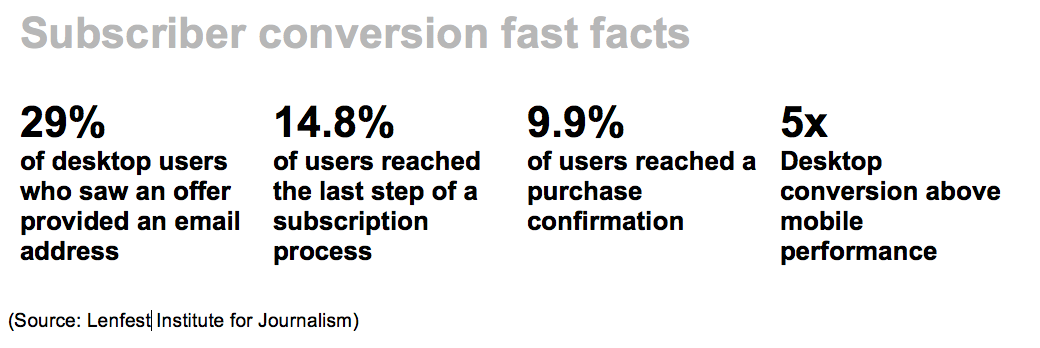
For high-performing publishers studied, optimization across each step of the subscription process was critical to success. Alongside this optimization, platform-led efforts, including Facebook Instant Articles, Facebook Analytics, Subscribe with Google, and Apple’s iOS subscription program, are helping publishers uncover opportunities to abridge these subscription steps.18
Key Finding: High-performing publishers tended to deploy two strategies – more rigorous meters (either a lower article limit or a shorter renewal period) and those with more open meters (a higher article limit).
Across publishers studied, for more rigorous meters, we identified a significantly higher average conversion rate as publishers reached a higher meter limit, peaking at a limit of 10 articles per 30-day period. Publishers with a 5-article limit generate more subscriptions due to a higher volume of stopped users. In short, in evaluating participating publishers, we identified a “tighter” meter limit would lead to a higher stop rate and more subscribers from a publisher’s existing audience. Some publishers studied were seeing effective subscription strategies at lower meter limits due to marketing and pricing strategies.
For more “open” meters, publishers were focused on generating audience growth (resulting in higher advertising revenue) rather than converting existing audiences. Across each approach, publishers must balance generating audience growth with opportunities to convert those audiences into subscribers.
Given this variety in outcomes, there are no “right” meter limits to convert a reader, and publishers can expect a wide range of performance at any meter limit. Publishers must be careful in testing these approaches; common errors include reducing a stop rate below a certain point where the news organization puts traffic at risk – and publishers that see this reduction typically need to increase the size of the publication’s overall market.

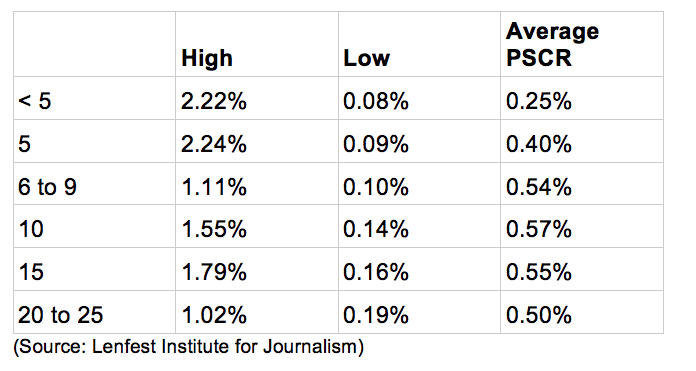
While conversion rates tend to drop over time, they do have peaks that correspond with promotional activity. Typically the PSCR of 1-2 percent is the leading average, while publishers below this range have poorly-performing marketing and/or promotional activity.
Key finding: Size (of market, of email list) doesn’t matter; quality does.
While the average price of digital-only monthly subscriptions began around $6.66 in 2011, subscription prices have tended to increase steadily during the past half-decade.19 The average price for a digital-only monthly subscription is now slightly higher than $10 per month, while median large metro dailies studied charge closer to $12.50 a month for digital-only subscriptions.20

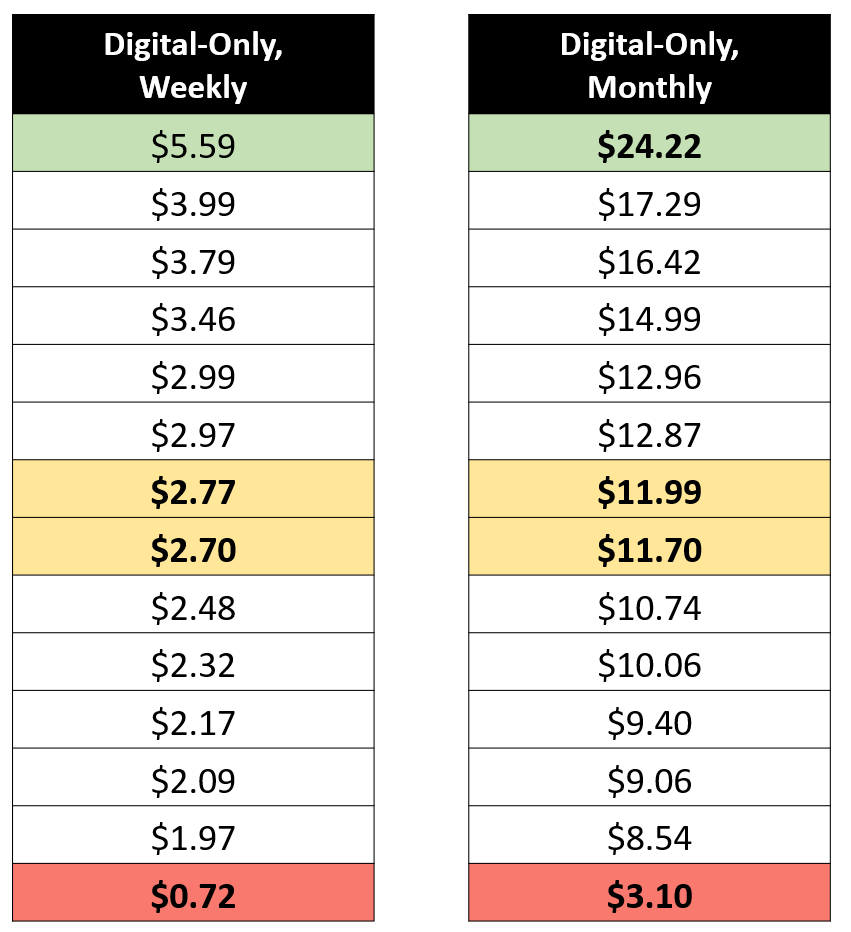
Our research found no significant correlation between the size of a publisher’s market (measured by print circulation size) and pricing. Other channels provide an important window into performance, but conversion rates still remain the most critical metric for a publisher’s focus.
While top-performing publishers tended to report higher-volume lists of email addresses and total newsletter subscribers, the volume of a publisher’s email list was not necessarily associated with high performance. In short, across the publishers studied, more emails did not always mean better outcomes.
The top 5 percent of publishers studied reported email lists of 5 million addresses and 1.8 million subscribers, on average, while the median of publishers studied reported 400,000 addresses and 270,000 subscribers, on average. Digital subscription strategies are not dependent on the email lists themselves, but rather how these newsletters and email lists are deployed and the quality of associated information, materials, and program design. High performing publishers tended to support email acquisition through opt-in choice architecture, email segmentation to drive engagement, and quality content designed to build value. For a deep dive on why list size does not predict a higher performance, and for more detail on the email metrics that matter to publishers, please see the Shorenstein Center’s paper Using Data Science Tools for Email Audience Analysis.

As publishers grow the top of their funnel, they must ensure they can convert existing readers and retain subscribers who enter it. Retention requires engagement strategies that cater to the preferences and characteristics of both subscribers and non-subscribers.
We recommend readers review existing reports from the Shorenstein Center and co-produced with the Columbia Journalism Review, a Guide to Audience Revenue and Engagement, and the Shorenstein Center’s Single Subject News Project.
Improving Subscriber Engagement
Key finding: Engagement (repeat audience attention) drives business success.
Subscriber engagement measures the percentage of digital subscribers who logged in during a given month by the number of active subscriptions in that month. Research across publishers underscores that engagement matters – the top decile of publishers studied have engagement rates that nearly 3 times those of the bottom decile. While monthly digital-only pricing does not offer a clear guide to subscriber churn, we found a positive correlation between subscriber engagement and retention among the publishers studied.21 As a leading indicator of retention, successful news organizations tend to give subscribers regular reasons to engage and keep them returning, month after month.


The best performing publishers studied in the cohort analyzed tended to leverage content strategy, social media engagement, offline events, video, email, newsletters, and site optimization to increase engagement among audiences and subscribers. As a rule of thumb, generally all audience engagement activity that occurs prior to the subscription should continue post-subscription. Best practices included:
Establishing a Content Strategy Focused on Substance: Across the publishers studied, content strategies play an important role in engagement as well as sustaining subscribership. While social virality might appear promising, the alternative might be the case – articles with fewer social shares or lower page views might be more popular with subscribers than general audiences.
Site Recirculation: Site recirculation strategies additionally provide an opportunity for publishers to create more engaging relationships with their reporting, considering how to best drive a particular user to read the next article. Other approaches might evaluate what might appear in an infinite scroll following a particular article. Using propensity to subscribe scoring, a high-performing publisher might, for example, recirculate content based on the user’s prior section readership, rather than articles relevant to the previous article.
The Business Case for Local and Unique Content: According the publishers surveyed, users who view local news appear to be 2-5 times more likely to subscribe than those who view national and wire-sourced stories. Of news organizations studied, publishers that produce more local (and non-wire-sourced) stories tended to generate greater subscription sales. High-performing editorial and business teams tended to clearly identify the unique value proposition of local news, incorporating editorial and coverage to improve readers’ lives within their communities. Critically, our analysis identified a correlation between subscription sales and amount of local content produced by the publication, reinforcing the business case for local reporting.
Information as a Service: Similarly to the business case for local content, publishers studied that provided “information as a service” to subscribers, including information that helps them live more informed lives, tended to see greater subscription sales. This category of information includes public transit and resource coverage and other information that does not require “reporting”.
Unique Content: High-performing publishers studied tend to offer a distinctive value proposition to the reader, incorporating reporting only that publication can provide. For example, one metro newspaper in a major college football market studied readership of its football coverage and found that pageviews in this category largely came from its coverage of the nationally recognized team in its market, an audience for which it competed heavily with national sports properties like ESPN. The publisher noticed a smaller school in the area had higher engagement from paying subscribers, and diverted resources to enhance coverage of the smaller school, driving subscriber engagement and reporting a greater number of new subscription starts.
Building Repeat Audience Attention: Effective publishers tend to help create “habit of news” among readers; the highest-performing publishers produce content readers want to refresh and read regularly. Our analysis found the most engaged subscribers expect daily and often hourly materials, rather than articles that merely resurface and repurpose content from the news organization’s print edition (if one exists). While wire stories help a publisher furnish regular content, wires tended to leave an audience impression of low quality of content. Publishers should prioritize customized, frequent local coverage that address a community’s particular needs, concerns, and interests.
Content Scoring and Evaluation: Across high-performing publishers studied, content elements were seen as sources of data to inform an exchange of value with the reader. Publishers should score content in the following users:
Charting a path to subscription using content scoring might enable a publisher to see articles that over-perform relative to the norm, and map patterns that emerge.
Newsletter and Email Signups: A variety of tactics tended to help a publication increase newsletter and email signups. These materials included overlays and modals, contests, slide-outs, registration reminders, embedded modules, and registration walls. Our surveys found publishers additionally experimented with tools from newsletter providers like Mailchimp to enable newsletter automation through RSS feeds. High-performing publishers also tended to leverage email sign-ups for direct subscription marketing and promotion; direct marketing tends to increase a reader’s likelihood of subscribing. Email newsletters also play an important role following the subscription action, increasing engagement and likely retention – and the best performing publishers see newsletters as editorial products of themselves. High-performing news organizations will track open rates, click-throughs and propensity describe through newsletters and optimize to maximize engagement. For more information on email newsletter best practices, please see the Shorenstein Center and Lenfest Institute’s Email Newsletter 201 Guide.
Site Optimization: Our analysis found site optimization (especially reducing website load times) remains a critical challenge for many publishers. Page load times represent the largest difference between successful publishers in the top decile and fiftieth percentile of publishers studied, with a median load times of 5.76 seconds.
Page load issues can generally challenge publishers, as revenue-generating activities such as third-party embeddable content marketing engines like Taboola or Outbrain tend to drain page load efficiency. Publishers might evaluate their return on investment on these third party features through benchmarking consumer experience and advertising revenue. Given the high lifetime value of a digital subscriber, a reduction programmatic advertising revenue might improve conversion or retention. Generally, that payoff can be calculated and estimated in advance using CLTV formulas.
Effective site optimizers avoid advertising overload, use real estate to drive readers to subscription options, and encourage content discovery through customized recommendations and infinite scrolls – offering seamless reading experiences in desktop and mobile environments.

Meter Optimization: Publishers might additionally explore optimizing how their meters function. Welcome messages offer an important avenue to capture readers and create email registration leads. Thirty percent of onsite digital subscriptions originate from “welcome” messages that provide an introduction to new readers, and ”warn” messages that serve as reminders as the reader approaches the meter limit. Successful publishers test multiple strategies to determine the most effective marketing messages for readers. Browser overlays and customized warnings have proven effective, particularly those that underscore meter limits for individual users and offer customized options for unique subscriptions based on the reader’s profile and viewing history.
The most effective stop messages include a single clear call to action, offer attractive introductory trial rates and include buttons that make clear the location(s) to click to advance the offer. Others include content-specific messages that link to the specific articles or sections the readers are pursuing. Publishers like the New York Times use homepage interstitials to maximize attention and page resources with marketing and subscription messages.
Checkout flows are an important and often-ignored step in driving toward a successful subscriber engagement. Publishers should limit registration and billing fields, include pre-checked (opt-out) marketing provisions wherever possible, and make clear the savings from trial rates.
Marketing and Promotion: Marketing and promotional best practices appeared to also improve publishers’ subscriber acquisition and performance. Effective marketing messages typically incorporate part or all of the below messages.
Publishers that excel in marketing and promotion typically focus house advertising, holiday promotions, seasonal offers, and flash promotions around these efforts, and punctuate these offers with content-specific promotions (e.g. promoting introductory rates for sports coverage heading into a particular season). Other publishers leverage retargeting and abandonment marketing tied to an abandoned cart or purchase experience.
High-performing publishers additionally message and optimize effectively once the user has completed an article or decided to stop reading; a news organization will ideally present them with the action that is of highest value, offering a sign-up if the user is not an email subscriber, or presenting articles in another section if the user has read three articles in a particular section. Efficient news organizations tend to consistently design user experiences and content with an eye toward what action the user might take next.
A Note on Customer Lifetime Value
Customer lifetime value (CLTV) is a critical benchmark for publishers; the CLTV measures the revenue value of each subscription sold, and is generated by averaging the average monthly subscription revenue per subscriber by the monthly churn rate. The variation in a publisher’s monthly churn rate matters – the higher the customer lifetime value, the more a publisher can generally spend on marketing and acquisition, according to publishers evaluated across our studies. The variation can be seen in the range of CLTV values: the bottom five percent of publishers studied reported a CLTV of approximately $50, while median publishers have a CLTV of $137, and the top 5 percent of publishers report a CLTV of $340.
While the benchmarks collected in our study examine each publisher’s average CLTV, successful publishers studied additionally prioritize understanding marginal customer lifetime value – that is, the projected lifetime value for new subscribers they convert through a particular marketing channel. This may require more granular analysis of particular subscriber cohorts, but can illuminate the tradeoff between the cost of acquiring a new subscriber and the projected revenue generated from that subscriber.
Retention
In addition to evaluating sales performance, the publishers studied prioritized retention by evaluating a month’s active customers relative to the previous month’s active customers. The median publisher sees a 94.4 percent retention rate, while the top 5 percent of publishers studied reported a 97 percent benchmark.
Retention rate is an important measure for publishers, as subscriber churn compounds over time and can lead to large changes in revenue with small drops in retention. Over the average lifetime of a subscription, for example, a publisher performing at the 90th percentile would, on average generate 36 percent more revenue (measured in terms of average customer lifetime value) than a publisher performing in the 70th percentile.22 The data show some association between a publisher’s median subscription price and its retention rate; publishers studied used site optimization techniques to test offers that keep subscribers engaged and reduce churn. These same publishers also tended to capture and optimize the sales activities that would concurrently drive new subscriptions.

Improving Retention
Our research found common strategies that might help improve and incentivize retention across a news organization. High-performing publishers tended to deeply understand the source of their churn – from the reason for cancellation to the causes of payment lapses.
Continuous touches with audiences ensure publishers carry on a dialogue with potential payers and existing subscribers. Program regular and dedicated engagement with subscribers through newsletters and social media – and categorize these efforts not only as new subscriber engagement, as observed in several newsrooms, but as targeting and tactical opportunities to engage existing subscribers as well. Prioritizing and sharing highlights, valued stories relevant to their content histories, and new and novel offerings with a regular cadence will help increase the likelihood a subscriber perceives the value of their ongoing relationship with your news organizations. These newsletters and other touchpoints should be approached with the same editorial and content integrity as any other arm of your operation, written in the voice and tone readers have come to expect. Any strategies in this vein require investment; these competencies require dedicated resources; the Economist, for example, has a team of 16 focused on retention alone.23
Publishers use research and operational teams to engage and reach out to canceled subscribers to determine what went wrong. They then create cyclical processes of feedback and evaluation to improve services to overcome future lapses. A conversation with one reader might represent the sentiments of many more, and every touchpoint can make a difference.
Good leaders appropriately acknowledge their people and the results they achieve. Reward the newsroom for content that engages subscribers, through traffic leaderboards, materials that show comparisons within a market or area, and by offering accolades to colleagues across the editorial and business functions.
Several additional strategies can provide critical to building a macro-level view of lapses and areas in which your news organization’s technology and offerings can better meet audience expectations:
The above study of large metro and local publishers offers guidance for how digital subscription models can indeed succeed and begin to thrive in a competitive news environment. Consumer and reader tastes are changing, and the growth of digital subscriptions across other sectors has broadly increased readers’ propensity to engage and, ultimately, subscribe.
The publisher models set new standards for engagement in the digital era. They offer highly appealing, customized information; treat their news organizations as vital resources to help new and existing readers live better lives; shape clear and value-capturing offers to convert engaged readers; and deliver ever-relevant content for existing subscribers to reduce churn.
The highest-performing practitioners in our analysis investigate options with message testing, and ensure all subscription and retention efforts are data-driven and continuously optimized. Indeed, they are resourcing these efforts appropriately to see these results; larger publishers and their smaller counterparts are increasingly dedicating entire departments to these endeavors. Given operational constraints, not all publications can pursue the above audience development and engagement strategies concurrently, but several simple and low-cost approaches – modeled after best practices across the industry – might allow publishers to increase engagement, build a dedicated base of digital subscribers, and begin to reduce a reliance on advertising revenue.
About the Shorenstein Center on Media, Politics and Public Policy
The Shorenstein Center on Media, Politics and Public Policy is a Harvard University research center dedicated to exploring and illuminating the intersection of press, politics and public policy in theory and practice. The Center strives to bridge the gap between journalists and scholars, and between them and the public.
About the Lenfest Institute for Journalism
The Lenfest Institute for Journalism is the first-of-its-kind non-profit organization whose sole mission is to develop and support sustainable business models for great local journalism.
About the Authors
Nicco Mele
Nicco Mele is on the faculty at the Shorenstein Center on Media, Politics, and Public Policy at the Harvard Kennedy School and is the faculty co-chair of the Harvard Council on the Responsible Use of Artificial Intelligence. From 2016 to 2019, Nicco was the Director of the Center, where he started new programs focused on understanding misinformation on social networks; sustainable models for local journalism; institutional anti-racism in media and algorithms; and platform accountability. He took over leadership of the Center in 2016 after serving as Senior Vice President and Deputy Publisher of the Los Angeles Times and as the Wallis Annenberg Chair in Journalism at the University of Southern California. He is the author of The End of Big: How The Internet Makes David the New Goliath and co-founder of EchoDitto (now Echo & Co.), a leading internet strategy and consulting firm. Mele also is a board member of the Nieman Foundation for Journalism at Harvard and a Senior Fellow at the USC Annenberg Center on Communication Leadership & Policy.
Matt Skibinski
Matt Skibinski is an advisor to the Lenfest Institute, and is the current General Manager of NewsGuard. As general manager, he contributes to NewsGuard’s operations, marketing, product direction and overall strategy as a member of its New York office. Before joining NewsGuard, Skibinski was a member of the founding team at Press+, a digital subscription platform for news publishers. Serving as the organization’s Vice President for Publisher Relations, he helped grow the company from a new startup into a successful business serving over 500 news publishers worldwide.
Since leaving Press+ after its merger with Piano Media in 2015, he served on the Board of Directors and in various operational roles at an education nonprofit, The Future Project, and has worked with a range of prominent newspapers, magazines and digital news publishers on digital strategy and subscription strategy as a consultant. Skibinski advises The Lenfest Institute, a journalism nonprofit, on digital benchmarks and best practices for news, and is frequently invited to present on the topic at industry conferences and events.
Skibinski graduated from Tufts University in 2009, where he majored in political science and served as the editor-in-chief of The Tufts Daily.
Matthew Spector
Matthew Spector is a senior strategic consultant at the management consultancy SYPartners and was a research affiliate for this project at the Shorenstein Center on Media, Politics, and Public Policy.
Rooted in his early work in broadcast and digital journalism at ABCNews and Good Morning America, Matthew guides clients from media and political campaigns to NGOs and advocacy organizations to adapt to changing communities, audiences, and industries. Matthew held an appointment as a visiting researcher at the Brookings Institution’s Center on Governance Studies, led the launch social media and digital team for the Defending Digital Democracy Project at Harvard’s Belfer Center, and was World Economic Forum delegate at its Center for the Fourth Industrial Revolution. He has previously contributed to Shorenstein Center research including recent reports on political communications and field scans across the digital media landscape, and for digitalHKS in technology shifts in digital government discipline.
Matthew graduated from Northwestern University’s School of Communication in 2010 and served as managing editor of the Daily Northwestern, and received the master in public policy from Harvard’s Kennedy School of Government in 2018, serving as a managing editor of the Kennedy School Review.
The following terms-of-art play a critical role in defining a shared vocabulary across the operational domains discussed below:
Market penetration – a publication’s digital audience as the percentage of a publication’s given digital desktop market.
Audience engagement – the number of users who view a certain number or range of unique articles in a given month. For example, the number of users who view more than five articles in a given month is one commonly used measure of audience engagement.
Meter – a digital gate for readers designed to limit the content that can be viewed for free on a publisher’s site before the user is prompted to sign up and/or subscribe – the gate is typically set by the number of articles read in a given period of time, generally a 30- or 45-day window.
Meter stop rate – the number of users stopped by a meter or paywall in a given month over unique visitors during that period
Paid stop conversion rate (PSCR) – the number of readers who subscribe in a given time period as a percentage of total users stopped by a meter during that time.
Average publishing revenue per user (ARPU) – the revenue generated per active user during a particular time frame (typically the duration of the meter – 30 or 45 days).
Churn and retention – the percentage of subscriber attrition over time
Average customer lifetime – the average duration of a subscriber
Engaged subscriber – a subscriber who engages with digital content at least once in a given time period, typically 30 days
Average account activation rate – rate at which account activation occurs across a given addressable population; this activation might include print subscribers entitled to digital access with their subscription

Videos


Explainers, Podcasts, Videos